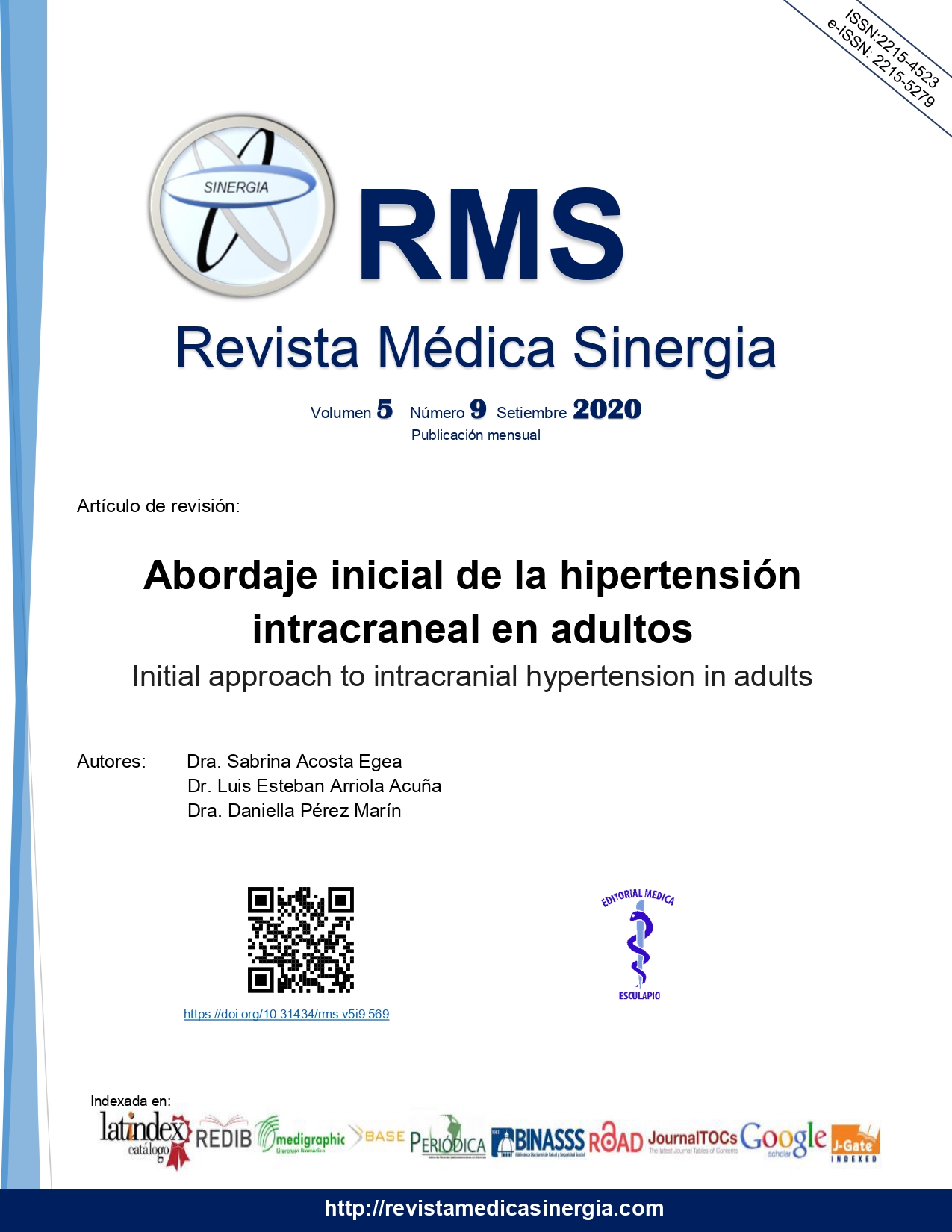Resumen
La presión intracraneal normal oscila entre 5-15mmHg. Cuando se eleva por encima de 20mmHg por más de 10 minutos, se define como hipertensión intracraneal. Trauma craneoencefálico, tumores y hemorragias cerebrales son posibles causas de hipertensión intracraneal. El paciente cursa con síntomas como bradicardia, hipertensión arterial y depresión respiratoria. Las principales medidas de abordaje incluye elevar la cabecera, sedación, control de presión arterial, mantener la presión de perfusión cerebral >60mmHg y el uso de manitol y/o solución salina hipertónica. La hiperventilación es una medida terapéutica. La profilaxis antiepiléptica es controversial. La hipotermia ha demostrado neuroprotección. Las posibles complicaciones si se retrasa el manejo incluyen edema cerebral grave y daños neurológicos irreversibles.
Palabras clave
Citas
Rodríguez G, Rivero M, Gutiérrez R, Márquez J. Conceptos básicos sobre la fisiopatología cerebral y la monitorización de la presión intracraneal. Neurología. 2015;30(1):16-22.https://doi.org/10.1016/j.nrl.2012.09.002
Ragland J, Lee Kiwon. Critical Care Management and Monitoring of Intracranial Pressure. J Neurocrit Care. 2016; 9(2):105-112. https://doi.org/10.18700/jnc.160101
Changoor N, Haider A. Pharmacological and Surgical Treatment of Intracranial Hypertension. Curr Trauma Rep. 2015 (1):155-159. https://doi.org/10.1007/s40719-015-0021-z
Freeman D. Management of Intracranial Pressure. Continuum. 2015; 21(5):1299-1323. https://doi.org/10.1212/CON.0000000000000235
Ahmad S, Moss H. Update on the diagnosis and treatment of Idiopathic Intracranial Hypertension. Semin Neurol 2019;39:682-691.https://doi.org/10.1055/s-0039-1698744
Moscote L, Rubiano A. Monitoreo de la presión intracraneal en neurotrauma: conceptos generales. Rev Trau Amer Lat. 2015;5(3): 126-128
García J, Zapata R, Vázquez F, Rodriguez S, Medina M, Torres J. Monitorización de la presión intracraneal en traumatismo craneoencefálico severo. Rev Chil Pediatr. 2016;87(5): 387-394. https://doi.org/10.1016/j.rchipe.2016.04.006
Geeraerts T, Velly L, Abdennour L. Management of traumatic brain injury (first 24 hours). Anaesth Crit Care Pain Med 37 (2018) 171-186. https://doi.org/10.1016/j.accpm.2017.12.001
Changa A, Czeisler B, Lord A. Management of elevated intracranial pressure: a Review. Curr Neurol Neurosci Rep. 2019 Nov 26;19(12):99. https://doi.org/10.1007/s11910-019-1010-3
Llorente G, Niño M. Manitol versus solución salina hipertónica en neuroanestesia. Rev Colomb Anestesiol. 2015;43(1): 29-39. https://doi.org/10.1016/j.rca.2014.07.010
Wakerley B, Tan M, Ting. Idiopathic intracranial hypertension. Cephalalgia. 2015;35(3): 248-261. https://doi.org/10.1177/0333102414534329
Markey K, Mollan S, Jensen R, Sinclair A. Understanding idiopathic intracranial hypertension: mechanisms, management, and future directions. Lancet Neurol. 2016; 15: 78-91. https://doi.org/10.1016/S1474-4422(15)00298-7
Lazaridis C, Robertson C. Hypothermia for Increased Intracranial Pressure: Is It Dead? Curr Neurol Neurosci Rep. 2016; 16(9). https://doi.org/10.1007/s11910-016-0681-2
Tang C, Bao Y, Qi M, Zhou L, Liu F, Mao J, Qui B. Mild Induced Hypothermia for Patients with Severe Traumatic Brain Injury after Decompressive Craniectomy. J Crit Care. 2017; 39: 267-270. https://doi.org/10.1016/j.jcrc.2016.12.012
Smith, M. Refractory Intracranial Hypertension. Anesth Analg. 2017; 125(6): 1999-2008. https://doi.org/10.1213/ANE.0000000000002399
Moscote L, Alvis H, Ramos Y, Quintana L, Rubiano A, Alcalá G, Hipertensión intracraneal traumática refractaria: el papel de la craniectomía descompresiva. Cir Cir. 2019;87(3):358-364. https://doi.org/10.24875/CIRU.18000081
Giammattei L, Messerer M, Oddo M, Borsotti F, Levivier M, Daniel R. Cisternostomy for Refractory Posttraumatic Intracranial Hypertension. World Neurosurg. 2018; 109: 460-463. https://doi.org/10.1016/j.wneu.2017.10.085

Esta obra está bajo una licencia internacional Creative Commons Atribución-NoComercial 4.0.
Derechos de autor 2020 Array


